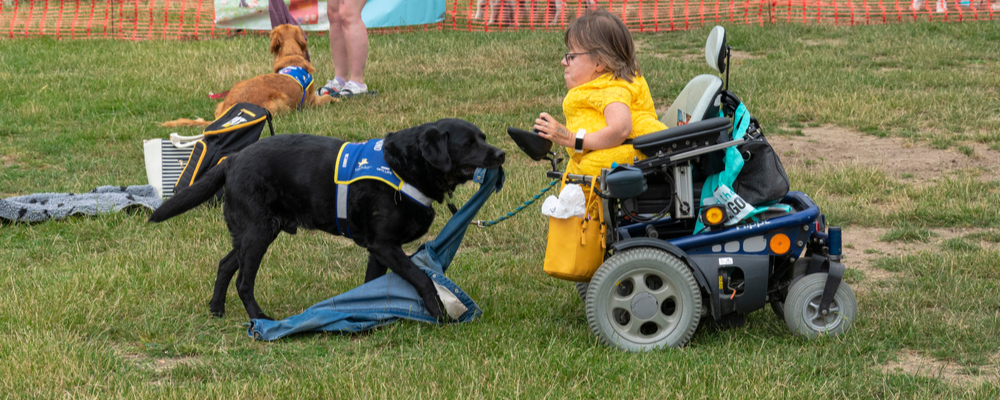 A service dog retrieves a jacket for his handler. Image Credit: Shutterstock Images, 2019.
A service dog retrieves a jacket for his handler. Image Credit: Shutterstock Images, 2019.
By Christina "Cg" Garrard and Charlotte Stasio
Ideally, people would never have contact with a service animal unless it was their own. This can make it difficult in emergencies, however, when responders might need to interact with an animal whose owner needs help. Knowing what to expect is the first step to ensuring positive interactions in such cases.
Service animals are dogs (or sometimes miniature horses) that are individually trained to do work or perform tasks for people with disabilities, as defined by the Americans with Disabilities Act (ADA). An individually trained animal is one that has been trained for a particular person to take specific actions that are needed to assist with that person’s disability.
Service Animals in Action
Service animals need to be concentrated on the incredibly important job of keeping their owners (officially called “handlers”) safe. This is often noted on the vests they wear with phrases such as “do not pet,” “ignore me,” or “do not distract.” Many people don’t even realize service dogs are working at all times—they are closely attuned to signs from their handler, ready to take action if needed.
Here’s an example of what it might it look like when a service dog is on the job:
Let’s say that a service dog has been individually trained to assist their handler with posttraumatic stress disorder, which impacts the central nervous system and can cause panic attacks, loss of awareness, and other debilitating symptoms. These symptoms could be dangerous if they occurred when a person wasn’t in a safe place—that’s where the service dog comes in.
Since the dog has been trained to detect tiny changes in their handler’s nervous system, they’ll realize when the handler is about to have a panic attack and alert them by pulling on a sleeve, whining, or in some way getting their owner’s attention. The service dog will identify a safe place, such as a couch, and guide the handler to it. If the panic attack occurs at home, they might open a drawer, retrieve medications, and deliver them to the handler. They could also open the refrigerator, get a bottle of water, and deliver that to their handler.
During the attack, the dog may lick their handler’s face to focus their attention on the present and can perform deep pressure therapy to decrease the levels of stress hormones in their handler’s body. If the handler gets into an unsafe position, the service dog will use their body to move the handler’s back to safety. After the panic attack, they will comfort their handler and nudge them until they have taken their medication.
In an actual situation such as this, a service dog would have performed a minimum of fifteen specially trained tasks in about a half hour. That is why it is so important to not interrupt service animals when they are working. They have an important job and they need all their attention to do it.
Service Animals in an Emergency
Now, let’s say a service dog’s handler is hurt and they call an ambulance for assistance. When emergency responders arrive, it will be incredibly important that they do not separate the service dog from handler.
Emergency responders do not need to spend time figuring out if a service dog is legitimate—if the dog is not a safety risk, it should remain with its owner where it can continue to provide physical and psychological support. This will allow emergency responders to care for the patient—and the animal might even provide help by alerting responders to medical emergencies.
The only circumstances where service animals should be separated from their handler is in the case of a legitimate safety risk, according to the ADA. Legitimate safety risks would include an animal who is out of control or not housebroken, or in an environment that requires sterility, such as a burn unit or operating room.
If the animal's presence in an ambulance would interfere with the ability to treat the patient, that could also be considered a safety risk. In such a case, however, emergency responders should arrange for the animal to be transported to the receiving facility where it can be reunited with its owner.
Ultimately, both emergency responders and service dogs share the same goal—to provide life-saving and stabilizing support to a person with a disability. When responders understand the roles a service animal plays in keeping their owners safe, it will be easier for everyone to work together.
Learn More at the Natural Hazards Workshop: Cg Garrard and Charlotte Stasio of Griffin, LLC will host a training session to educate first responders and others about working with service animals. Read about the session here.
Cg Garrard is an emergency management consultant, who also happens to have a disability. She has worked with federal, state, and local governments, as well as engaged local communities and private-sector partners in emergency planning and resilience efforts. Garrard excels at building relationships with stakeholders and engaging in productive discussion of inclusion, equity, diversity, and anti-racism in emergency management operations. Garrard earned a master’s degree in hazards geography from the University of South Carolina, where she worked at the Hazards and Vulnerability Research Institute. Garrard conducts business with the support of her service dog and “Chief Barketing Officer,” Wynona Earp.